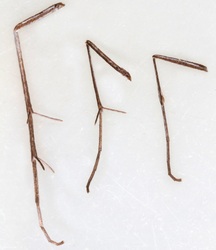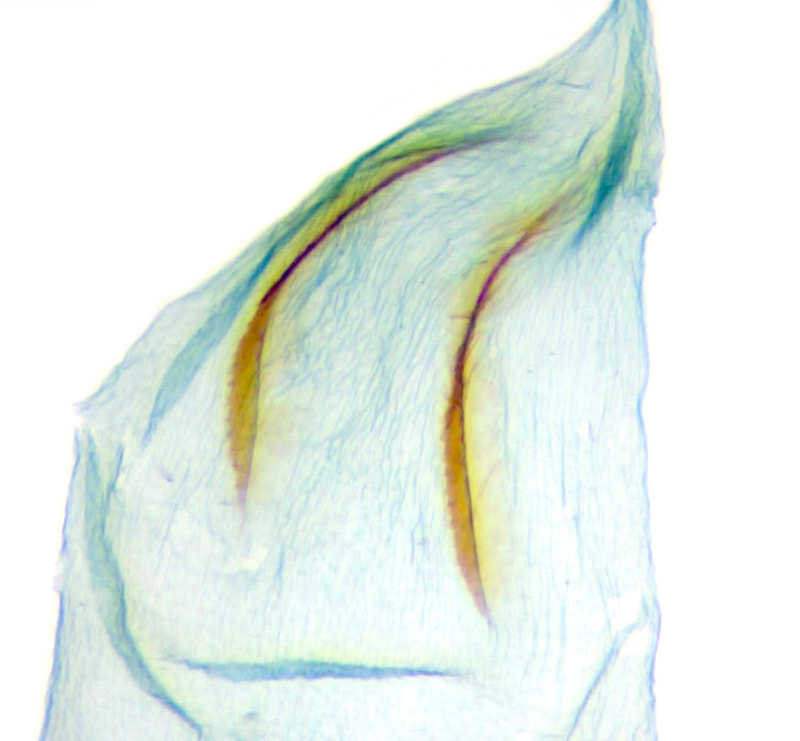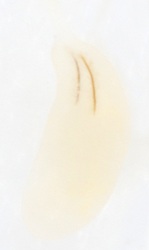45.033 Merrifieldia leucodactyla (Thyme Plume)
ws: 18-25mm; Jun-Aug; wild thyme (Thymus polytrichus); local on chalk downland, sea cliffs and sand dunes throughout GB.
ID: M.tridactyla is very similar, but is confined to SW.England. Hart distinguishes these species on forewing features: in M.tridactyla the costal cilia of the 2nd lobe are a mixture of short pale hairs and long dark hairs which obscures the boundary between the wing and its cilia; in M.leucodactyla these hairs are mostly dark and the boundary between the wing and its cilia appears sharply defined. In M.tridactyla the ochreous-brown suffusion of the basal 2/3 of the forewing often extends into the forewing lobes; in M.leucodactyla the forewing lobes are without this suffusion and invariably white. Gielis gives the pattern of dark and pale scales in the antennae as the best external distinguishing feature, but his text description is hard to reconcile with his illustration. The illustration shows what I think is the dorsal aspect of the antenna with 3-4 scales across the width of the antenna; in M.tridactyla there is a line of dark scales bordered by white scales along the length of the antenna; in M.leucodactyla there is a more random pattern of dark and white scales, but still a dominance of white scales. In specimen §1, I found a substantial dominance of dark scales. M.baliodactylus is also similar but the dark costal line is much less distinct; it is confined to England, mainly in the south.
Male genitalia:
M.leucodactyla: left sacculus ending in a slender curved spine the same length as the broad basal portion, the whole sacculus longer than the valve; right sacculis ending in a broad hook.
M.tridactyla: left sacculus ending in a slender curved spine much shorter than the broad base, the whole sacculus a little shorter than the valve; right sacculus ending in a slender curved spine (which appears shorter in the dissection group images than in Gielis's illustration)
M.baliodactylus: L saccular spine short and stout, the whole sacculus much shorter than the valve; right saccular spine angulated at apex.
Female genitalia:
M.leucodactyla and M.tridactlya have a pair of longitudinal thread-like signa in the bursa copulatrix. They differ in the proximal margin of the 7th tergite which possesses a long and short process in M.leucodatyla, these processes being absent in M.tridactyla. In M.baliodactylus the signa are wedge-shaped.
Male genitalia:
M.leucodactyla: left sacculus ending in a slender curved spine the same length as the broad basal portion, the whole sacculus longer than the valve; right sacculis ending in a broad hook.
M.tridactyla: left sacculus ending in a slender curved spine much shorter than the broad base, the whole sacculus a little shorter than the valve; right sacculus ending in a slender curved spine (which appears shorter in the dissection group images than in Gielis's illustration)
M.baliodactylus: L saccular spine short and stout, the whole sacculus much shorter than the valve; right saccular spine angulated at apex.
Female genitalia:
M.leucodactyla and M.tridactlya have a pair of longitudinal thread-like signa in the bursa copulatrix. They differ in the proximal margin of the 7th tergite which possesses a long and short process in M.leucodatyla, these processes being absent in M.tridactyla. In M.baliodactylus the signa are wedge-shaped.
DIssection
Male genitalia
Female genitalia
§1 Ardnamurchan, Highland; 05/07/2011; male; fw 9.8mm
§2 Ardnamurchan, Highland; 13/07/2012; female; fw 8.5mm
§3 Mull; 19/06/2018; female; fw 8.6mm
All images © Chris Lewis
§2 Ardnamurchan, Highland; 13/07/2012; female; fw 8.5mm
§3 Mull; 19/06/2018; female; fw 8.6mm
All images © Chris Lewis
Page published 06/04/2012 (§1) | §2 added and text amended 07/12/2012 | §3 added 21/04/2019























